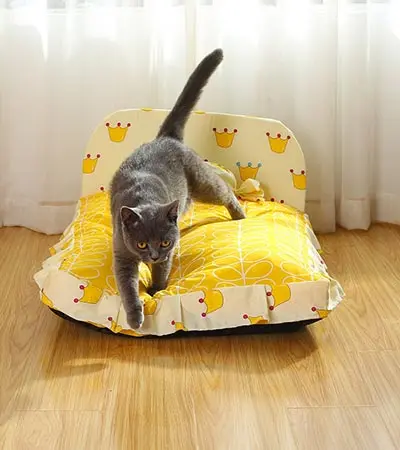Introduction
Choosing the right bed for pet is essential for their comfort, health, and well-being. With so many options available, it can be overwhelming to decide which pet bed is best suited for your furry friend. This comprehensive guide will help you understand the different types of pet beds, key factors to consider when selecting a bed, and tips for maintaining it. By the end of this guide, you’ll be well-equipped to make an informed decision that ensures your pet enjoys a restful and cozy sleep.
Understanding Different Types of Pet Beds

Pet beds come in various shapes, sizes, and materials, each designed to meet specific needs and preferences. Here are some of the most common types of pet beds available:
Standard Pet Beds
Standard pet beds are simple, cushion-like beds that come in various shapes (rectangular, oval, or round) and sizes. They are usually filled with foam, polyester, or cotton, and covered with fabric. These beds are suitable for most pets and offer basic comfort and support.
Orthopedic Pet Beds
Orthopedic pet beds are designed for pets with joint issues, arthritis, or other orthopedic problems. They are made with memory foam or other supportive materials that contour to the pet’s body, providing optimal support and reducing pressure on joints.
Heated Pet Beds
Heated pet beds are perfect for pets that get cold easily or for use in colder climates. These beds come with built-in heating elements that provide gentle warmth, ensuring your pet stays cozy and comfortable.
Elevated Pet Beds
Elevated pet beds, also known as raised beds, have a platform that lifts the pet off the ground. This design promotes airflow and helps keep pets cool, making it ideal for warmer climates or pets with thick fur.
Nesting or Donut Pet Beds
Nesting or donut pet beds feature a circular design with raised edges, creating a cozy, enclosed space for pets to curl up in. These beds are great for pets that love to feel secure and surrounded while they sleep.
Covered Pet Beds
Covered pet beds, also known as hooded or cave beds, provide a semi-enclosed space that mimics a den. These beds are ideal for pets that enjoy a sense of privacy and security.
Factors to Consider When Choosing a Bed for Pet
Selecting the perfect pet bed involves considering several factors that affect your pet’s comfort and health. Here are the key aspects to keep in mind:
Size and Weight of Your Pet
Ensure the bed is appropriately sized for your pet. A bed that is too small will be uncomfortable, while a bed that is too large may not provide the sense of security some pets desire. Measure your pet while they are lying down to get an accurate size, and check the weight limit of the bed to ensure it can support your pet.
Sleeping Style and Behavior
Observe your pet’s sleeping habits. Do they like to stretch out or curl up? Do they prefer a warm, enclosed space or an open, airy spot? Understanding your pet’s sleeping style will help you choose a bed that meets their preferences.
Health and Age of Your Pet
Consider any health issues or age-related problems your pet may have. Older pets or those with joint problems may benefit from orthopedic beds, while pets that get cold easily might prefer heated beds.
Material and Durability
Choose a bed made from durable, high-quality materials that can withstand regular use and washing. Look for beds with removable, machine-washable covers for easy cleaning. Ensure the bed is made from non-toxic materials, especially if your pet has allergies or sensitivities.
Ease of Cleaning
Pets can bring dirt, hair, and odors to their beds, so it’s essential to choose a bed that is easy to clean. Opt for beds with removable, washable covers and materials that resist stains and odors.
Budget
Pet beds come in a wide range of prices, so determine your budget before shopping. While it’s tempting to go for the cheapest option, investing in a high-quality bed can save you money in the long run, as it will last longer and provide better support for your pet.
Maintaining and Cleaning Your Bed for Pet
Proper maintenance and cleaning are crucial for ensuring your pet bed stays hygienic and lasts longer. Here are some tips for maintaining and cleaning your pet bed:
Regular Cleaning Schedule
Set a regular cleaning schedule to keep the bed free from dirt, hair, and odors. Depending on the material and your pet’s habits, aim to wash the bed cover and vacuum the bed itself every 1-2 weeks.
Use Pet-Friendly Detergents
When washing the bed cover or bed itself, use pet-friendly detergents that are free from harsh chemicals and fragrances. This will prevent skin irritations and allergies in your pet.
Check for Wear and Tear
Regularly inspect the bed for signs of wear and tear, such as loose threads, holes, or flattened padding. Repair or replace the bed as needed to ensure your pet continues to have a comfortable and safe place to sleep.
Rotate Beds
If your pet has multiple beds, rotate them regularly to distribute wear evenly and extend the lifespan of each bed. This also gives you an opportunity to clean one bed while your pet uses the other.
Use Protective Covers
Consider using protective covers or liners under the bed cover to prevent damage from spills, accidents, or excessive shedding. These can be easily removed and washed, keeping the bed itself cleaner for longer.
Comparison of Popular Pet Beds
To help you choose the right pet bed, here is a comparison of some popular types of pet beds based on key factors such as comfort, durability, and price:
| Type of Pet Bed | Comfort Level | Durability | Best For |
|---|---|---|---|
| Standard Pet Bed | Moderate | Moderate | General use |
| Orthopedic Pet Bed | High | High | Pets with joint issues |
| Heated Pet Bed | High | Moderate | Pets in cold climates |
| Elevated Pet Bed | Moderate | High | Pets in warm climates |
| Nesting/Donut Bed | High | Moderate | Pets that like to curl up |
| Covered/Cave Bed | High | Moderate | Pets that seek privacy |
Conclusion: Bed for Pet
Choosing the perfect bed for your pet is a vital decision that can significantly impact their comfort and well-being. By understanding the different types of pet beds, considering key factors such as size, sleeping style, and health, and maintaining the bed properly, you can ensure your pet enjoys a restful and happy sleep. Investing time and effort into selecting the right pet bed will pay off with a healthier, happier pet who feels loved and cared for.
FAQ
How often should I replace my pet’s bed?
The frequency of replacing your pet’s bed depends on the quality of the bed and your pet’s habits. High-quality beds can last several years with proper maintenance, but you should replace the bed if it shows significant wear and tear, loses its shape, or becomes difficult to clean.
Can I wash my pet’s bed in a washing machine?
Many pet beds come with removable covers that can be washed in a washing machine. Always check the manufacturer’s care instructions to ensure you’re cleaning the bed correctly. For beds without removable covers, spot cleaning or using a pet-safe upholstery cleaner may be necessary.
What type of pet bed is best for a dog with arthritis?
For dogs with arthritis, an orthopedic pet bed is the best choice. These beds are made with memory foam or other supportive materials that provide optimal support and reduce pressure on the joints, helping to alleviate pain and discomfort.
Are heated pet beds safe to use?
Heated pet beds are generally safe to use, as long as they meet safety standards and are used according to the manufacturer’s instructions. Ensure the bed has an automatic shut-off feature to prevent overheating and check the heating element regularly for any signs of damage.
How do I choose the right size pet bed?
To choose the right size pet bed, measure your pet while they are lying down in their natural sleeping position. Add a few inches to this measurement to ensure they have enough space to stretch out comfortably. Refer to the manufacturer’s sizing guide for additional recommendations based on your pet’s weight and breed.
